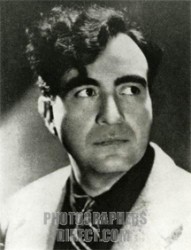[We continue Hispanic Heritage Month’s salute to Latin American and Latino composers with a biography of the Mexican composer Carlos Chavez]
By: Daniel Nardini
 Mexico has produced some of the world’s greatest composers of classical symphonic music. One of these great composers was Carlos Chavez. Carlos Antonio de Padua Chavez y Ramirez was born on June 13, 1899, in Mexico City. Although his father, Agustin Chavez, died when Carlos was only three years old, he had made a fortune for his family by inventing and patenting a plough that was used in both Mexico and the United States. Carlos Chavez was first taught how to play the piano by his brother Manuel Chavez, and Carlos learned about the music of the Nahua and other indigenous Mexican peoples on his travels through Mexico with his family. The music of the indigenous peoples greatly influenced Carlos Chavez, and their music would become part of his symphonies and shorter works. While growing up in Mexico City he learned more about music and music composition.
Mexico has produced some of the world’s greatest composers of classical symphonic music. One of these great composers was Carlos Chavez. Carlos Antonio de Padua Chavez y Ramirez was born on June 13, 1899, in Mexico City. Although his father, Agustin Chavez, died when Carlos was only three years old, he had made a fortune for his family by inventing and patenting a plough that was used in both Mexico and the United States. Carlos Chavez was first taught how to play the piano by his brother Manuel Chavez, and Carlos learned about the music of the Nahua and other indigenous Mexican peoples on his travels through Mexico with his family. The music of the indigenous peoples greatly influenced Carlos Chavez, and their music would become part of his symphonies and shorter works. While growing up in Mexico City he learned more about music and music composition.
After the Mexican Revolution, Chavez began his musical career. His works strongly reflected both European and traditional indigenous musical traditions. Of his six major symphonies, his best known and most popular one is Symphony No. 2 which incorporates Yaqui native wind instruments. In 1922, Chavez married Otilla Ortiz, and the couple went vacationing in Europe for seven months. In 1923, Chavez visited the United States for the first time, and he was so impressed that country he returned to America countless times during his life. In the 1920’s, Chavez composed some of his famous works such as the “The New Fire” and “The Four Suns” both of which are heavily Aztec-themed pieces. In the 1930’s, Chavez wrote numerous sonatas and concerts that were heavily influenced by Mexican folk songs. Despite the Great Depression of the 1930’s, Chavez’s works and Chavez himself as a composer were in great demand both in Mexico and outside.
From this period and into the 1950’s, Chavez traveled throughout Mexico, Europe and the United States. From 1947 to 1952, Chavez was director-general of the National Institute of Fine Arts in Mexico City, and in 1947 he formed the National Symphony Orchestra in Mexico City. Chavez was a visiting symphony conductor for many orchestras in Europe and the United States and even gave lectures at Harvard University from 1957-1959. In the 1960’s and 1970’s demand for Chavez and his works declined dramatically. Because of this he lost considerable money and eventually was forced to sell his home in Mexico City and move into the suburban home of his daughter Anita in Coyoacan. Despite these setbacks, he still wrote compositions to the end of his life. It was in Coyoacan that Chavez died in relative obscurity on August 2, 1978. His death brought back interest from many quarters about his life and works. His papers and musical manuscripts are now housed in such famous places as the New York Public Library for the Performing Arts and the National Archive of Mexico in Mexico City. Carlos Chavez, whose named became a revered icon throughout Mexico, is again a revered icon throughout the world of symphony.
 Ease the Holiday Blues with CDPH Programs December 19, 2025
Ease the Holiday Blues with CDPH Programs December 19, 2025
 Rogers Park Business Alliance Expands Annual Live Love Shop Rogers Park December 18, 2025
Rogers Park Business Alliance Expands Annual Live Love Shop Rogers Park December 18, 2025






Carlos Chavez
[We continue Hispanic Heritage Month’s salute to Latin American and Latino composers with a biography of the Mexican composer Carlos Chavez]
By: Daniel Nardini
After the Mexican Revolution, Chavez began his musical career. His works strongly reflected both European and traditional indigenous musical traditions. Of his six major symphonies, his best known and most popular one is Symphony No. 2 which incorporates Yaqui native wind instruments. In 1922, Chavez married Otilla Ortiz, and the couple went vacationing in Europe for seven months. In 1923, Chavez visited the United States for the first time, and he was so impressed that country he returned to America countless times during his life. In the 1920’s, Chavez composed some of his famous works such as the “The New Fire” and “The Four Suns” both of which are heavily Aztec-themed pieces. In the 1930’s, Chavez wrote numerous sonatas and concerts that were heavily influenced by Mexican folk songs. Despite the Great Depression of the 1930’s, Chavez’s works and Chavez himself as a composer were in great demand both in Mexico and outside.
From this period and into the 1950’s, Chavez traveled throughout Mexico, Europe and the United States. From 1947 to 1952, Chavez was director-general of the National Institute of Fine Arts in Mexico City, and in 1947 he formed the National Symphony Orchestra in Mexico City. Chavez was a visiting symphony conductor for many orchestras in Europe and the United States and even gave lectures at Harvard University from 1957-1959. In the 1960’s and 1970’s demand for Chavez and his works declined dramatically. Because of this he lost considerable money and eventually was forced to sell his home in Mexico City and move into the suburban home of his daughter Anita in Coyoacan. Despite these setbacks, he still wrote compositions to the end of his life. It was in Coyoacan that Chavez died in relative obscurity on August 2, 1978. His death brought back interest from many quarters about his life and works. His papers and musical manuscripts are now housed in such famous places as the New York Public Library for the Performing Arts and the National Archive of Mexico in Mexico City. Carlos Chavez, whose named became a revered icon throughout Mexico, is again a revered icon throughout the world of symphony.